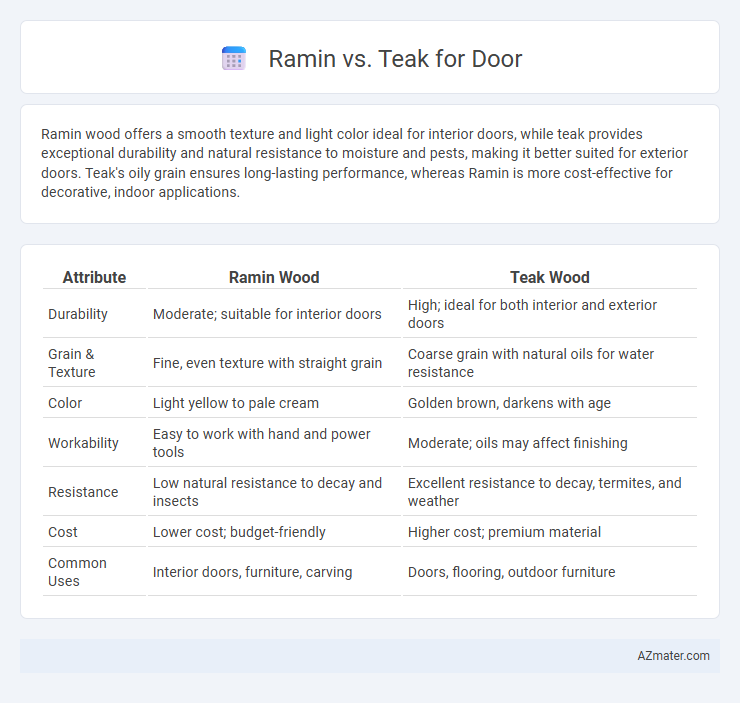Ramin wood offers a smooth texture and light color ideal for interior doors, while teak provides exceptional durability and natural resistance to moisture and pests, making it better suited for exterior doors. Teak's oily grain ensures long-lasting performance, whereas Ramin is more cost-effective for decorative, indoor applications.
Table of Comparison
| Attribute | Ramin Wood | Teak Wood |
|---|---|---|
| Durability | Moderate; suitable for interior doors | High; ideal for both interior and exterior doors |
| Grain & Texture | Fine, even texture with straight grain | Coarse grain with natural oils for water resistance |
| Color | Light yellow to pale cream | Golden brown, darkens with age |
| Workability | Easy to work with hand and power tools | Moderate; oils may affect finishing |
| Resistance | Low natural resistance to decay and insects | Excellent resistance to decay, termites, and weather |
| Cost | Lower cost; budget-friendly | Higher cost; premium material |
| Common Uses | Interior doors, furniture, carving | Doors, flooring, outdoor furniture |
Introduction: Ramin vs Teak for Doors
Ramin is a lightweight, pale softwood known for its affordability and ease of use in door manufacturing, making it ideal for interior doors and budget-friendly projects. Teak is a dense, durable hardwood prized for its natural oils, resistance to moisture, and rich golden-brown color, making it the preferred choice for high-end exterior doors and areas exposed to harsh weather. Choosing between Ramin and Teak hinges on factors like durability, aesthetic appeal, cost, and specific environmental conditions of the door's application.
Overview of Ramin Wood
Ramin wood, sourced from the Shorea genus in Southeast Asia, is prized for its pale yellow to light brown color and smooth, straight grain, making it ideal for door manufacturing. Its softness and moderate durability allow for easy machining and finishing, providing a smooth surface that accepts paints and stains well. Compared to teak, ramin is more affordable but less resistant to moisture and pests, making it suitable for indoor doors where cost and workability are prioritized.
Overview of Teak Wood
Teak wood is highly valued for door construction due to its exceptional durability, natural resistance to moisture, insects, and decay, and rich golden-brown color that deepens with age. Its dense grain and oily texture make teak doors highly resistant to warping and cracking, ensuring long-lasting structural integrity in various climates. Often preferred over Ramin, teak offers superior strength and aesthetic appeal, making it a premium choice for both interior and exterior doors.
Durability Comparison: Ramin vs Teak
Teak wood exhibits superior durability due to its natural oils, making it highly resistant to moisture, pests, and decay compared to Ramin. Ramin, although moderately durable and suitable for interior doors, lacks the inherent rot-resistant properties of teak, resulting in shorter lifespan in outdoor or high-humidity environments. Teak's exceptional hardness and stability ensure long-term structural integrity and low maintenance, outperforming Ramin in durability for door applications.
Resistance to Moisture and Termites
Ramin wood offers moderate resistance to moisture but is more susceptible to termite attacks compared to teak. Teak wood is highly durable, with natural oils providing exceptional resistance to moisture and termite infestations, making it ideal for door construction. Choosing teak over ramin significantly enhances the longevity and durability of exterior doors in humid or termite-prone environments.
Aesthetic Differences: Grain and Color
Ramin wood features a fine, even grain with a light creamy to pale yellow hue that offers a smooth and uniform aesthetic ideal for contemporary door designs. Teak exhibits a rich golden brown color with a pronounced, coarse grain pattern that deepens over time, giving doors a warm, luxurious appearance. The distinct grain texture and natural color variations in teak provide a more rustic and traditional look compared to the subtle elegance of ramin.
Cost and Availability
Ramin wood is generally more affordable than teak due to its faster growth rate and wider availability in Southeast Asia, making it a budget-friendly option for doors. Teak, prized for its durability and natural oils, commands a higher price and is less abundant, often sourced from sustainable plantations to meet demand. The cost difference between ramin and teak can significantly impact project budgets, with ramin providing a cost-effective alternative when availability and price are primary concerns.
Maintenance Requirements
Ramin doors demand minimal maintenance due to their dense grain and natural resistance to termites and rot, requiring only occasional cleaning and polishing to maintain their smooth, light-colored finish. Teak doors need regular upkeep, including oiling and sealing, to preserve their rich color and prevent weathering, as teak's natural oils can diminish over time when exposed to moisture and sunlight. Both woods benefit from protective treatments, but ramin offers lower long-term maintenance efforts, making it ideal for indoor settings.
Sustainability and Environmental Impact
Ramin wood, harvested primarily from Southeast Asia, faces sustainability challenges due to overexploitation and slower growth rates, raising concerns about deforestation and habitat loss. Teak, sourced from managed plantations and natural forests, offers better sustainability when certified, as its fast growth and durability reduce the need for frequent replacement, lowering environmental impact. Choosing FSC or PEFC-certified teak and ramin ensures responsible forest management, minimizing carbon footprint and supporting biodiversity conservation in door manufacturing.
Which Wood is Best for Your Door?
Ramin wood offers a lightweight and affordable option with fine grain ideal for interior doors, while teak is prized for its exceptional durability, natural oils, and resistance to moisture, making it the best choice for exterior and high-traffic doors. Teak's dense, oily texture withstands weathering and insect damage, ensuring long-lasting performance and a luxurious appearance. For ultimate durability and longevity, especially in harsh environments, teak is the superior wood for doors compared to ramin.

Infographic: Ramin vs Teak for Door
 azmater.com
azmater.com